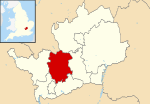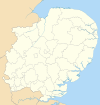City of St Albans
City of St Albans | |
|---|---|
 | |
|
Coat of arms of City of St Albans Coat of arms | |
 St Albans shown within Hertfordshire | |
| Sovereign state | United Kingdom |
| Constituent country | England |
| Region | East of England |
| Non-metropolitan county | Hertfordshire |
| Status | Non-metropolitan district, Borough, City |
| Admin HQ | St Albans |
| Incorporated | 1 April 1974 |
| Government | |
| • Type | Non-metropolitan district council |
| • Body | St Albans City Council |
| • Leadership | Leader & Cabinet |
| • MPs | Anne Main Peter Lilley |
| Area | |
| • Total | 62.23 sq mi (161.18 km2) |
| • Rank | (of 296) |
| Population (2022) | |
| • Rank | (of 296) |
| • Ethnicity | 90.9% White 4.1% S.Asian 1.7% Black 1.9% Mixed Race 1.4% Chinese or Other |
| Time zone | UTC0 (GMT) |
| • Summer (DST) | UTC+1 (BST) |
| ONS code | 26UG (ONS) E07000100 (GSS) |
| OS grid reference | TL148073 |
| Website | www |
The City of St Albans /s[invalid input: 'ɨ']nt ˈɔːlbənz/, also known as the City and District of St Albans or District of St Albans, is a local government district, in Hertfordshire, England. It was created in 1974 and since then has held the status of non-metropolitan district and city. The local authority is St Albans City Council. It has routes to the M1 motorway via the A414 road (formerly the M10 motorway), and rail routes to London St Pancras and Watford via St Albans City railway station and St Albans Abbey railway station respectively.
Geography
The district includes St Albans (population c. 58,000), Harpenden (population c. 27,600), the parishes of Colney Heath, Harpenden Rural, London Colney, Redbourn, St Michael's, St Stephen's (including the villages of Chiswell Green and Bricket Wood), Sandridge and Wheathampstead. Nearby places outside the district include Hatfield to the east, Welwyn Garden City to the northeast, Luton and Dunstable to the northwest, Hemel Hempstead to the west, Watford to the southwest and Borehamwood to the south.
Governance
The local authority is St Albans City Council, which also calls itself St Albans City and District Council and St Albans District Council. The irregular sounding name reflects the diverse nature of the area covered, with two main urban areas and several villages; typically districts with the status of cities are known simply as Cities, for example the City of Peterborough or the City of York.
The district was created on 1 April 1974 as a merger of the City of St Albans, the Harpenden Urban District and most of St Albans Rural District. City status had been granted to the municipal borough of St Albans in 1877, following the elevation of St Albans Abbey to cathedral.[1] The status was granted to the entire district by letters patent dated 9 July 1974.[2]
References
- ^ "No. 24502". The London Gazette. 11 September 1877.
- ^ "No. 46352". The London Gazette. 24 September 1974.

